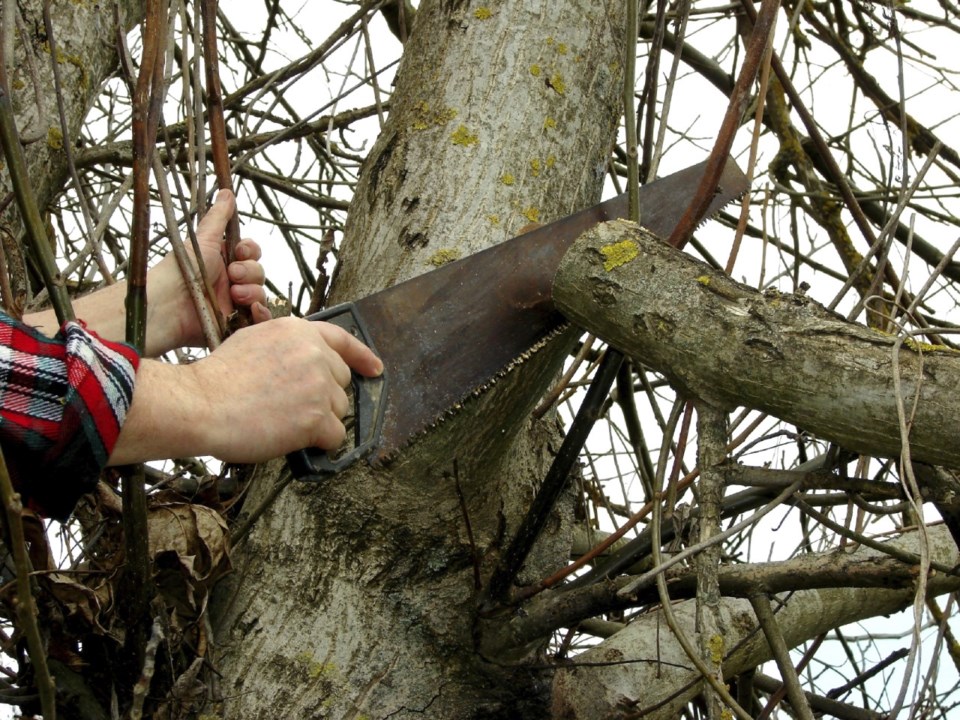The following column was submitted to the Tri-City News from Brian Minter — master gardener, best-selling author, Order of Canada recipient and co-owner of Minter Country Garden Store.
There is no putting it off any longer.
We really must start getting our trees and shrubs back into shape before the dormant season ends.
Pruning extends the life of trees, enhances their beauty and prevents them from becoming overgrown and crowding out other plants.
Let's start with evergreen conifers.
Junipers are probably the biggest problem when it comes to keeping shrubs in check. Whether they are low or medium spreading types, or an upright variety, they need to be pruned at least yearly to improve their appearance and to keep them from taking over.
With electric hedge trimmers or two-handled grass shears in hand, simply trim back into last year's growth while, at the same time, shaping the plant.
Low-spreading varieties usually look best in a fan shape, while uprights can vary depending upon their form, but I have found the narrower you prune them, the better they look.
If they get ahead of you, you may have to be a little more severe. Remember: If you prune back into the old hard wood, it will take a long time for the juniper to look good again.
There are, however, a couple of exceptions to note.
Whether they are compact ornamentals or tall specimens, all pine and spruce trees are best pruned in May.
The reason is that they grow by producing buds, or candles, that should be allowed to develop before pruning. If you cut the buds or candles off, it may be a whole year before any growth appears, leaving a rather chopped appearance.
Prune pines in May when the new candles are shooting up profusely. When this new growth is pruned, in the shape of the tree of course, a multitude of new buds will develop, ensuring much slower, fuller growth. You can even cut back into older wood at this time and still get bud development for next season. The pruned-back candles will continue to develop, creating a much more attractive tree.
The same is true of spruce trees and true fir or abies.
Let the new buds pop first, then prune following the shape of the tree. Although many new growth tips will be cut off, others back further on the branches will develop nicely to fill in the tree during the next growing season. Try to maintain a rather narrow form on all your spruce trees, especially blue spruce, to keep them looking their best without overtaking the landscape.
Many broadleaved evergreens can be pruned back now as well. For more tender varieties, it is often better to prune after our last hard frost, often in late February. Laurels, Photinia fraseri, summer-blooming heather, boxwood, euonymus and many others should be cut back fairly hard to maintain their shape and prevent them from becoming too big for their location.
A mid-summer pruning may also be necessary for very fast-growing broadleaved evergreens. Pieris japonicas, azaleas, camellias and rhododendrons should be trimmed just as their flowers begin to finish and new growth begins.
Most flowering shrubs should not be pruned now for fear of cutting off this year’s flowers.
As a rule of thumb, prune most varieties immediately after they flower. Mophead hydrangeas, lilacs and forsythias are classic examples. Weigelas, deutzia, potentillas and a few other flowering shrubs bloom on new growth and can certainly be pruned now.
When you prune flowering shrubs back immediately after blooming, keep two things in mind.
- First, try to keep them compact because they can so quickly overpower a garden. Many new, more dwarf varieties are solving this problem.
- Second, try to renew the plant by taking out the old hard wood, leaving the more recent growth from the past two years to give you good colour. This summer's growth on forsythia, for example, will not be as spectacular as last year's wood. Chinese witch hazels also bloom best on old wood. It is also a good idea to thin out shrubs, leaving lots of room for air and sunshine to circulate and penetrate. Look at the shape of the shrub before you prune and try to maintain or improve that shape.
Flowering trees, too, should be pruned after you have enjoyed their blossoms.
I follow three simple rules: first, cut out any diseased or damaged branches; second, cut out all the thin and wispy branches that grow toward the centre and clutter up the tree; third, cut back the ends of the major branches to check the growth. Always try to maintain the shape of the tree when pruning. Having someone on the ground directing where to make the cuts is a big help in maintaining the shape of the tree.
It takes a little work, but pruning is actually interesting and more enjoyable than you may think. You have to be a bit of an artist, and you get to judge your work next season when the blooms appear and new growth begins.





